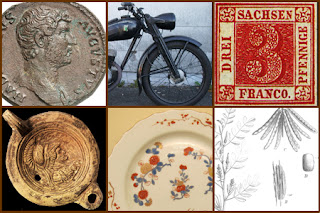City of Munich, vignette from the bond below
After being absent from the financial markets for 26 years, the city of Munich issued in 1994 a remarkable loan of 100,000,000 Deutsche Mark at 7.5% with a 10 year maturity. The certificate was decorated with a historical view of Munich and each of the ten coupons showed a different view of one of the city's buildings and places. The time to market was right and the loan was a succes.
(source: Münchens Stadtanleihen)
 |
Bayerische Landeshauptstadt München
7.5% Bond 100 DM, 1994
printed by Giesecke & Devrient
Source: A. Luckner
double-click image to enlarge |
What are Schmuckanleihen ?
Schmuck is German for jewelry, Anleihe means bond or loan. So Schmuckanleihen are German bonds decorated, not with jewels, but with attractive vignettes or photographs. What is typical for these certificates is that also the coupons can show different images.
Further, in order to reach the grand public as much as possible, these loans were issued with low nominal value certificates of 100 Deutsche Mark (at the time approx. 58 USD/51 EUR). After the Euro introduction, 100 EUR became the smallest denomination.
 |
Freie und Hansestadt Hamburg
7% Bond 100 DM, 1989
marking the 800th anniversary of the port
Source: A. Luckner |
Widespread application
The Free and Hanseatic City of Hamburg issued in 1989 one of the first Schmuckanleihen , see image above. After
the Wende, other cities, including some of the former German Democratic Republic, such as Leipzig, Dresden and Weimar, also raised money in this way. Even companies, like the Lufthansa airline, started issuing Schmuckanleiden and others ventured on Schmuckaktien (the
share variation).
 |
Stadt Leipzig
4.5% Bond 100 EUR, 1999
The certificate depicts the St. Thomas church.
The coupons show images from Bach and musical elements.
Source: A. Luckner |
But why were Schmuckanleihen interesting ?
Because of their attractive designs and low nominal values, more people than usual wanted and had the means to invest in such securities. At the other side, the issuer speculated that some borrowers would not redeem the bond. Many investors kept the certificates, with vignettes of their favorite city, as collector's items. Some of the owners did not cash the equally decorative coupons. In the end, the issuer got some of the money as a gift. No wonder several German soccer clubs saw the benefits of this type of financing. Soccer fans could invest in a wonderful certificate showing their dearest players from their favorite club.
 |
LEICA CAMERA AG
Share of 50 Deutsche Mark, 1996
The coupons show images of Leica cameras.
Source: A. Luckner |
In English, these type of modern German securities are sometimes defined as "artwork" loans but "design loans" may be a better description, and even that word does not completely carry the full meaning. Actually, the term
Schmuckanleihen is perhaps the best word to use, because, similarly to the word Jugendstil, the word refers not only to a certain kind of printed securities, but also to a location, the country Germany, and the period when these securities became popular all over the reunified country, 1990-2000. Yes, one could speak of the
Schmuckanleihen period.
 |
Bayerische Landeshauptstadt München
6.5% Bond of 100 DM, 1995
The certificate depicts “Blaues Pferd“ of the artist Franz Marc.
The coupons show works from artists group
Der Blaue Reiter (Marck, Kandinsky, Macke ..).
Source: A. Luckner |
By breaking with a tradition of plain and aesthetically often boring certificates, the introduction of Schmuckanleihen may have unintentionally popularized our hobby to the broad public in Germany and beyond, more than any other promotional attempt before.
F.L.
Related links







